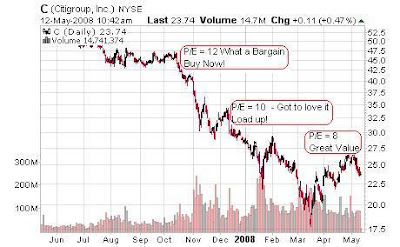One of the issues with trading the “Value Trap” many traditional fundamental investors fall into. Many investors buy into a stock because it appears cheap, only to watch it decline in value. At the stock drops further it looks cheaper, and the investor attempts to average in and buy even more shares because it now looks even cheaper. “If you liked it at $30 then you are going to love it $20,” goes the old expression.
Many investors screen simply on valuation criteria attempting to find stocks that look “cheap”. If the P/E, P/B, and other factors look good compared to other companies in the same industry then the stock is “on sale”; which is an invitation to hit the “buy” button. Warren Buffet and others talk about value, and many small investors attempt to imitate their “style”. However most of the institutional big boys are normally selling their portfolio about the same time smaller valuation investors are looking to buy in.
The problem with most value driven purchases for individual investors is that 70% of them do not pan out; the bulk of these failures incur significant losses. Most investors do not mine gems in their fundamental searches, instead they are digging up the debris from the discard heap. Many of these stocks are cheap for a reason, the reality is that they are either declining industries, are poorly managed, or are facing business challenges. The stocks hyped in the financial press as value plays are often the worst examples. Despite screening for both forward and backward fundamental ratios; many times the underlying problems are not apparent to value investors.
What are these investors missing?
The primary attribute the investor is forgetting about is price action when screening the universe of stocks. Simply scanning for “cheap” leads to a pile of probable losers. There is normally a reason a stock is a “value play”; in the same way there is a justification of why a used Yugo costs less than a Mercedes.
Investors need to take a firm look at price action as part of their valuation analysis; this means having a compete understanding of charting, technical analysis, and relative strength. In the example above, any basic analysis of moving averages, relative strength of Citi compared to other financial stocks, or evaluation of the chart would have quickly revealed that Citi was doomed during this time period – despite an “appealing valuation” at multiple points.
In order to avoid the 70% of the stocks in the scrap heap, value investors need to screen for more than just fundamental factors as part of their overall evaluation of candidates. The Hingefire stock screener provides a tool that supports evaluation on multiple fundamental and technical criteria which helps put the market edge in the corner of investors.
The problem with most value driven purchases for individual investors is that 70% of them do not pan out; the bulk of these failures incur significant losses. Most investors do not mine gems in their fundamental searches, instead they are digging up the debris from the discard heap. Many of these stocks are cheap for a reason, the reality is that they are either declining industries, are poorly managed, or are facing business challenges. The stocks hyped in the financial press as value plays are often the worst examples. Despite screening for both forward and backward fundamental ratios; many times the underlying problems are not apparent to value investors.
What are these investors missing?
The primary attribute the investor is forgetting about is price action when screening the universe of stocks. Simply scanning for “cheap” leads to a pile of probable losers. There is normally a reason a stock is a “value play”; in the same way there is a justification of why a used Yugo costs less than a Mercedes.
Investors need to take a firm look at price action as part of their valuation analysis; this means having a compete understanding of charting, technical analysis, and relative strength. In the example above, any basic analysis of moving averages, relative strength of Citi compared to other financial stocks, or evaluation of the chart would have quickly revealed that Citi was doomed during this time period – despite an “appealing valuation” at multiple points.
In order to avoid the 70% of the stocks in the scrap heap, value investors need to screen for more than just fundamental factors as part of their overall evaluation of candidates. The Hingefire stock screener provides a tool that supports evaluation on multiple fundamental and technical criteria which helps put the market edge in the corner of investors.


No comments:
Post a Comment